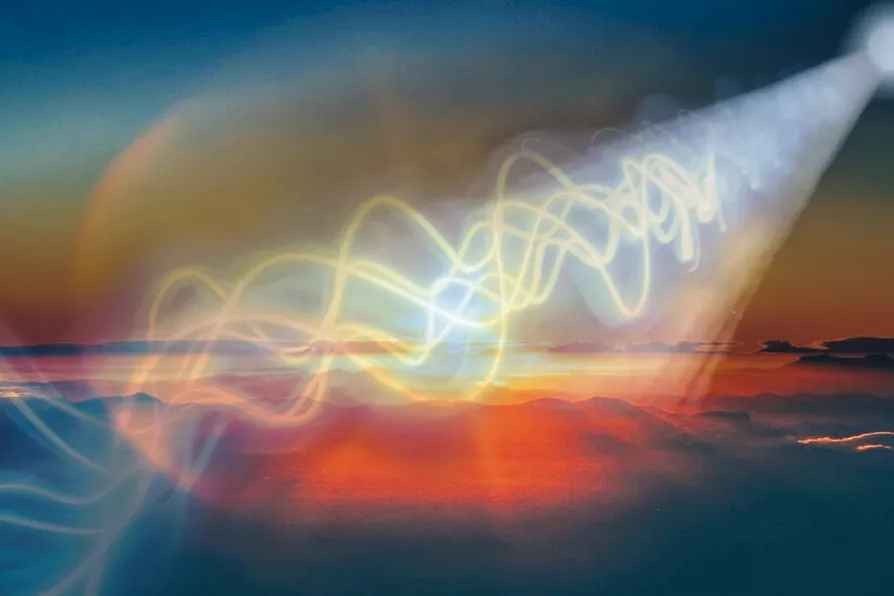KATE CLARK recalls an occasion when the president of the Scottish National Union of Mineworkers might just have saved a Chilean prisoner’s life

 Waves of light are surprisingly big, only a very tiny bit smaller than the smallest thing we can see — a good gauge for imagining the size of light is a thread in a spider web
Waves of light are surprisingly big, only a very tiny bit smaller than the smallest thing we can see — a good gauge for imagining the size of light is a thread in a spider web
LIGHT is a wave. But what is doing the waving? The abstract idea of a disembodied wave is extremely hard to conceive of. Just as you can’t imagine a wave in the ocean without the ocean, or a wave of a hand without a hand, it’s confusing that we would ever try to imagine a light wave without thinking about what the wave is travelling through.
In order to answer “what is waving,” the physicists who invented our modern description of light constructed the idea of the electromagnetic field. The field permeates every point of space in the universe, whether there is any matter or light at that point or not. The field at any point describes the amount and direction of electrical and magnetic force that is present at that place.
The wave that is light is a pulse of energy that passes in a straight line, carried as fluctuations in the electromagnetic field. Any point on the line undergoes a very quick change back and forth in the electric and magnetic forces as the light passes through. In fact the changing back and forth of the field is itself the light moving. Just like the way that water at the surface of a lake moves up and down as a ripple passes through the surface, and the movement up and down of the water is actually the ripple itself.
Why is it helpful to think about the wave-like nature of light? There are many effects that are easier to explain once you have the idea that light acts like a wave passing through a field.
One particularly striking feature is that when you imagine the light wave that passes through the field, it necessarily means that the wave takes up a certain amount of physical space.
The light wave has a length over which the light at any time is spread. To think about the water waves again, if you are on a boat bobbing up and down as waves pass underneath the boat, then the length of the wave is the distance between the peak of the wave you have reached the top of, and the next wave that you can see coming.
We tend to think of light itself as being unimaginably small. It is after all one of the fundamental elements of the universe. Unlike the pixels of an old-fashioned display screen, we don’t see individual points of light. And we never experience seeing something that is smaller than light – after all, how would we see it?
However, waves of light are in fact surprisingly big, only a very tiny bit smaller than the smallest thing we can see. It makes sense, given that our eyes have evolved to see light, that the scale we can see should match the size that light is.
A good gauge for imagining the size of light is a thread in a spider web. A thin but easily visible thread is four times wider than a wavelength of green light. Although different colours of light do have different wave-lengths, they are all of a fairly comparable size.
This scale on which the ripples of light travel through space is small – but it’s not that small. The width of a single atom, by comparison, is 5,000 times smaller than one of these waves.
Since all matter is made up of atoms, thousands of times smaller than visible light, there is a lot going on at this level that we cannot see. For example, in a cube of metal the size of a wavelength of green light on all three sides, there would be 125 billion atoms. But the cube would be invisible.
Somehow, light and matter still manage to interact despite their astonishing differences. One way they interact is the absorption of light by atoms and molecules. When this happens, light’s energy is absorbed inside the atom or molecule to increase its heat, or the energy of its electrons.
However, there is another way that modern physics tries to induce the interaction of light and matter: by building materials that are precisely scaled to interact with the waves of light.
Instead of simply absorbing the energy, materials on this scale can be engineered so that light interacts with matter to produce a new state – a hybrid of light and matter, with some of the properties of both. Many scientists and engineers are very excited about this, because of the potential to envisage new sorts of communication, computing and lasers. Researchers hope the future uses of the technology are yet to be imagined.
Step by step, small advances in this field are bringing a new way of working with light and matter into being. Due to intensive and well-funded research across the world, new results are being reported regularly, and changing the face of future technology, although we don’t notice, as many of the results are technical, or require a background understanding of the phenomenon to appreciate their significance.
The University of Southampton is a major centre of research into understanding how to hybridise light and matter in this way, and how to manipulate and use it, making many of these results close to home.
The hybridisation of light and matter means that the size of the light can be reduced, thanks to the much smaller scales on which matter exists. The size of the new state can be made hundreds of thousands of times smaller than the length of the light wave needed to carry the same energy. This is just one of the properties that gets people excited about the phenomenon.
However, last week researchers from Southampton working collaboratively with researchers in Zurich announced that there is a lower limit to the size into which a light-matter hybrid wave can be compressed. They showed that there is a limit below which the light cannot be confined by the size of the matter, and instead leaks out and dissipates.
The limit was found theoretically and then demonstrated with an experiment using light waves similar to microwaves. For these long waves, the limit is well within the fabrication limit of current technology. The huge size of light’s wave is likely to remain a significant challenge to using it even for the next generation of light-based technology.

The distinction between domestic and military drones is more theoretical than practical, write ROX MIDDLETON, LIAM SHAW and MIRIAM GAUNTLETT

Nature's self-reconstruction is both intriguing and beneficial and as such merits human protection, write ROX MIDDLETON, LIAM SHAW and MIRIAM GAUNTLETT

A maverick’s self-inflicted snake bites could unlock breakthrough treatments – but they also reveal deeper tensions between noble scientific curiosity and cold corporate callousness, write ROX MIDDLETON, LIAM SHAW and MIRIAM GAUNTLETT
Science has always been mixed up with money and power, but as a decorative facade for megayachts, it risks leaving reality behind altogether, write ROX MIDDLETON, LIAM SHAW and MIRIAM GAUNTLETT














